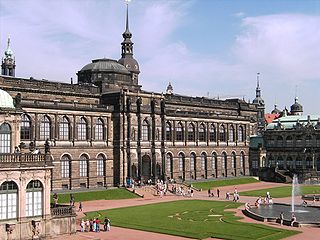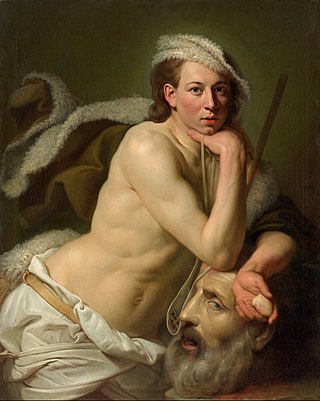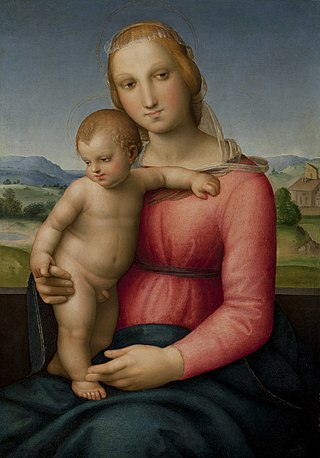
The National Gallery of Art is an art museum in Washington, D.C., United States, located on the National Mall, between 3rd and 9th Streets, at Constitution Avenue NW. Open to the public and free of charge, the museum was privately established in 1937 for the American people by a joint resolution of the United States Congress. Andrew W. Mellon donated a substantial art collection and funds for construction. The core collection includes major works of art donated by Paul Mellon, Ailsa Mellon Bruce, Lessing J. Rosenwald, Samuel Henry Kress, Rush Harrison Kress, Peter Arrell Browne Widener, Joseph E. Widener, and Chester Dale. The Gallery's collection of paintings, drawings, prints, photographs, sculpture, medals, and decorative arts traces the development of Western art from the Middle Ages to the present, including the only painting by Leonardo da Vinci in the Americas and the largest mobile created by Alexander Calder.
Lord Dingwall is a title in the Peerage of Scotland. It was created in 1584 for Andrew Keith, and in 1609 for Sir Richard Preston, with remainder to his heirs whatsoever. In 1619 he was further honoured when he was made Baron Dunmore and Earl of Desmond in the Peerage of Ireland, with remainder to heirs male. On his death in 1628 the Irish titles became extinct while he was succeeded in the Scottish lordship by his daughter Elizabeth, the second Lady Dingwall. She was the wife of James Butler, 1st Duke of Ormonde. Their eldest son Thomas Butler, Earl of Ossory, was summoned by writ to the English Parliament as Baron Butler, of Moore Park, in 1666. However, he predeceased his parents who were both succeeded by their grandson, the second Duke and third Lord Dingwall. He had already succeeded his father as second Baron Butler. However, the Duke was attainted in 1715 and his titles forfeited. In 1871, Francis Cowper, 7th Earl Cowper, managed to obtain a reversal of the attainder of the lordship of Dingwall and barony of Butler and became the fourth Lord Dingwall and third Baron Butler. He was the great-great-great-grandson of Henrietta d'Auverquerque, Countess of Grantham, second daughter of Thomas Butler, Earl of Ossory and 1st Baron Butler, whose second daughter Lady Henrietta de Nassau d'Auverquerque married William Clavering-Cowper, 2nd Earl Cowper. In 1880 he also succeeded his mother as eighth Baron Lucas of Crudwell. For later history of the lordship of Dingwall and barony of Butler, see the Baron Lucas of Crudwell.

The Madonna and Child Enthroned with Saints, also known as the Colonna Altarpiece, is a painting by the Italian High Renaissance artist Raphael, executed c. 1503-1505. It is housed in the Metropolitan Museum of Art of New York City. It is the only altarpiece by Raphael in the United States.

The Gemäldegalerie Alte Meister in Dresden, Germany, displays around 750 paintings from the 15th to the 18th centuries. It includes major Italian Renaissance works as well as Dutch and Flemish paintings. Outstanding works by German, French, and Spanish painters of the period are also among the gallery's attractions.

The Alba Madonna is a tondo (circular) oil on wood transferred to canvas painting by the Italian High Renaissance artist Raphael, created c. 1511, depicting Mary, Jesus, and John the Baptist in a typical Italian countryside.

The Garvagh Madonna is an oil painting by the Italian Renaissance artist Raphael, dating to c. 1509–1510. It depicts the Virgin, the Christ Child and the infant John the Baptist, and is one of many paintings by Raphael with this trio. It is from early in the artist's third, or Roman period, in which distinctive changes are seen from his Umbrian or Florentine period in style and use of colour, with the introduction of more natural subjects and settings.

Johan Joseph Zoffany was a German neoclassical painter who was active mainly in England, Italy and India. His works appear in many prominent British collections, including the National Gallery, the Tate Gallery and the Royal Collection, as well as institutions in continental Europe, India, the United States and Australia. His name is sometimes spelled Zoffani or Zauffelij.
Events from the year 1508 in art.

The Tribuna of the Uffizi is an octagonal room in the Uffizi gallery, Florence, Italy. Designed by Bernardo Buontalenti for Francesco I de' Medici in 1584, the most important antiquities and High Renaissance and Bolognese paintings from the Medici collection were and still are displayed here. The structure is octagonal because, according to Christian tradition, eight is the number which draws near Heaven. In 1737 the Grand Duchess Anna Maria Luisa de' Medici ceded the collection to the Tuscan government, and by the 1770s the Uffizi was the hub for Grand Tourists visiting Florence.

The Tribuna of the Uffizi (1772–1778) by Johan Zoffany is a painting of the north-east section of the Tribuna room in the Uffizi in Florence, Italy. The painting is part of the United Kingdom's Royal Collection.

The Soviet sale of Hermitage paintings in 1930 and 1931 resulted in the departure of some of the most valuable paintings from the collection of the State Hermitage Museum in Leningrad to Western museums. Several of the paintings had been in the Hermitage Collection since its creation by Empress Catherine the Great. About 250 paintings were sold, including masterpieces by Jan van Eyck, Titian, Rembrandt, Rubens, Raphael, and other important artists. Andrew Mellon donated the twenty-one paintings he purchased from the Hermitage to the United States government in 1937, which became the nucleus of the National Gallery of Art in Washington, D.C.

Panshanger was a large country house located between the outer edge of Hertford and Welwyn Garden City in Hertfordshire, England.

The Small Cowper Madonna is a painting by the Italian High Renaissance artist Raphael, depicting Mary and Child, in a typical Italian countryside. It has been dated to around 1504–1505, the middle of the High Renaissance.

Colonel Mordaunt's Cock Match, sometimes called Colonel Mordaunt's Cock Fight, is a painting by the German British artist Johann Zoffany. It records British colonial life in the Indian court of Asaf-Ud-Dowlah. The painting was completed in February 1788, four years after the event it records. The painting is part of the Tate Gallery collection. A recent cleaning has revealed the original colours and made more apparent what appears to be an erection visible on the Nawab of Oudh, the central figure.

George Nassau Clavering-Cowper, 3rd Earl Cowper was an English peer who went on the Grand Tour as a young man, but actually emigrated. Despite becoming a member of parliament and later inheriting lands and the title of Earl Cowper in England, he remained in Italy. He amassed a valuable art collection and became a Prince of the Holy Roman Empire. He was a patron of the arts and science.

St. George and the Dragon is a small oil on wood cabinet painting by the Italian High Renaissance artist Raphael, painted c. 1505, and now in the National Gallery of Art in Washington, D.C. The saint wears the blue garter of the English Order of the Garter, reflecting the award of this decoration in 1504 to Raphael's patron Guidobaldo da Montefeltro, Duke of Urbino, by King Henry VII of England. The first word of the order's motto, "HONI" can be made out. The painting was presumably commissioned by the Duke, either to present to the English emissary who brought the regalia to Urbino, Sir Gilbert Talbot, or to Henry himself—recent scholarship suggests the latter. The honour paid to a minor Italian ruler reflected Henry's appreciation of the cultural prestige of Renaissance Italy as much as any diplomatic purpose.

Portrait of Pope Julius II is an oil painting of 1511–1512 by the Italian High Renaissance painter Raphael. The portrait of Pope Julius II was unusual for its time and would carry a long influence on papal portraiture. From early in its life, it was specially hung at the pillars of the church of Santa Maria del Popolo, on the main route from the north into Rome, on feast and high holy days. Giorgio Vasari, writing long after Julius' death, said that "it was so lifelike and true it frightened everyone who saw it, as if it were the living man himself".

The Madonna and Child with Saints Luke and Catherine of Alexandria, also known simply as Holy Conversation, is a painting by the Italian Renaissance master Titian. It is one of his several versions of the canonical image of the Madonna and Child.

Charles Loraine Smith or Charles Loraine was a sportsman, artist and politician. He inherited his family seat in Enderby, Leicestershire while still a boy. He was a keen horseman and his paintings of animals are well regarded. He painted both parodies and more serious subjects. He served in the British parliament, was mentioned in a divorce case, met the pope and rose to be a High Sheriff of Leicestershire.

The Virgin and Child, commonly known as The Northbrook Madonna after the Northbrook Collection in England, is a painting from the early 16th century by an unknown artist possibly identified as Domenico Alfani. It is in the permanent collection of the Worcester Art Museum in Worcester, Massachusetts, United States. It was formerly attributed to Raphael, but scholars have since concluded otherwise.


















